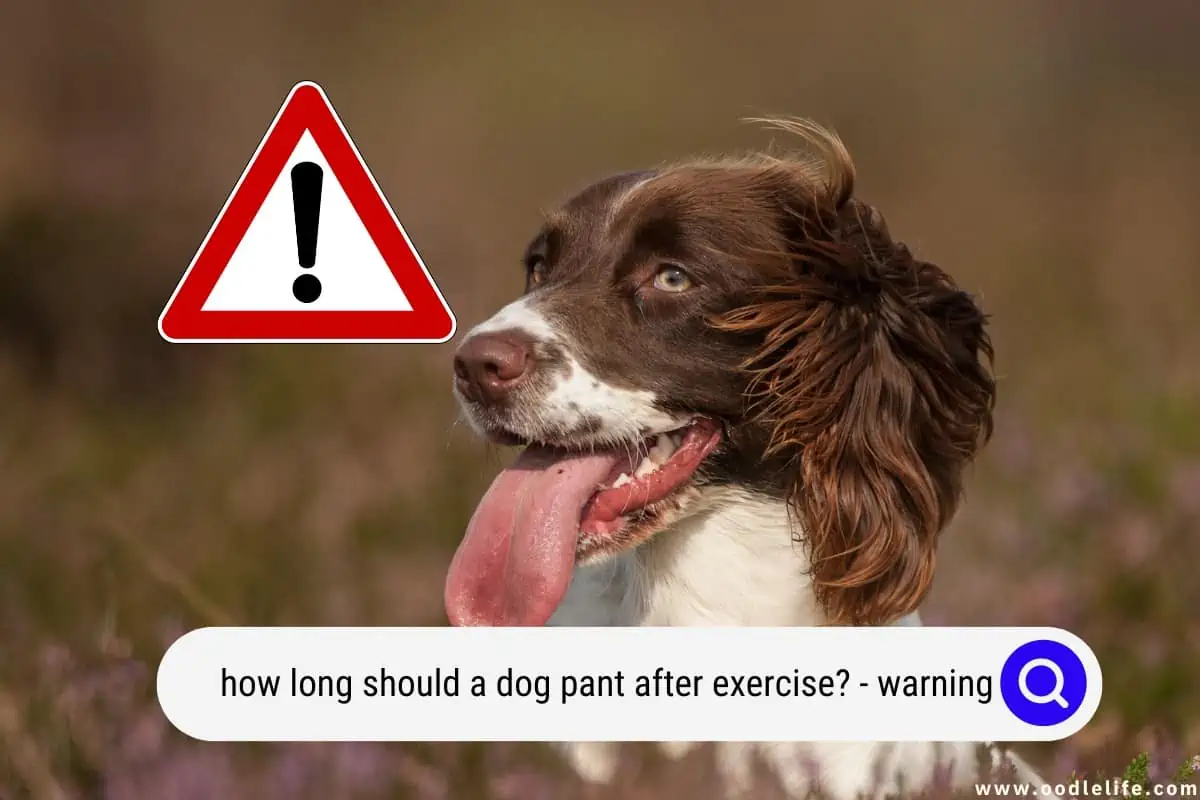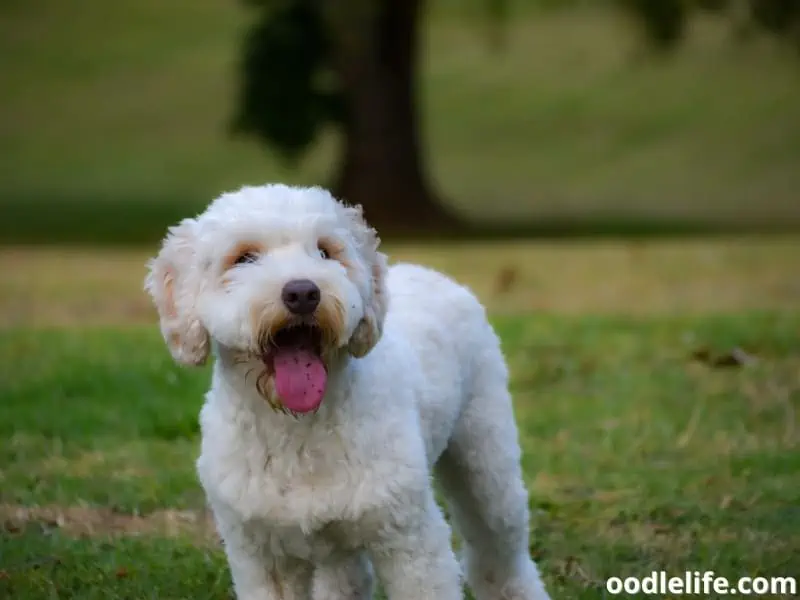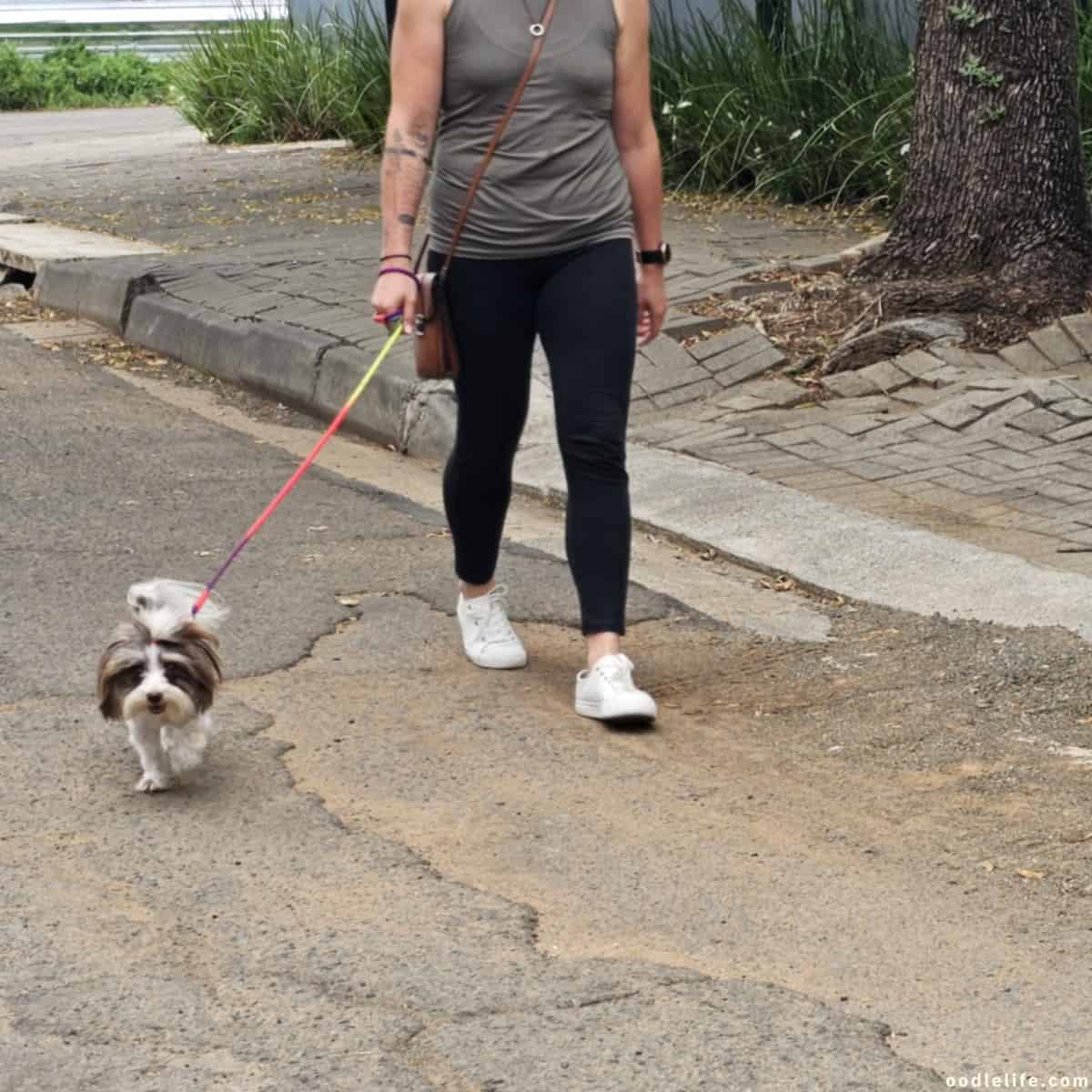How Long Should a Dog Pant After Exercise? [Warning]
Panting is a normal action for a dog, and you may not pay much attention to when and how long your dog pants. However, excessive panting can indicate pain or a medical condition.
You shouldn’t be overly concerned every time your dog pants, but it is a good idea to know how long should a dog pant after exercise.

Get familiar with what is normal for your dog, and learn about the factors that can influence panting, so you know when it is something to worry about.
What Is Panting?
Panting is how a dog cools its body temperature when it gets too hot. Since dogs’ bodies are covered with fur that insulates them, sweating is not an effective way to cool off as it is for humans.

When a dog pants, air passes over the mucous membranes in its mouth and nose, evaporating moisture. Since evaporation requires heat, when moisture evaporates, it takes heat from the surrounding moisture, leaving it cooler.
The dog breathes in air, heat, and moisture are transferred to it, and the dog exhales it again. The faster the breathing, the more quickly this process takes place, and the faster the dog cools down.
Panting is normal after exercise or playing, being outdoors in hot temperatures, or excitement. But if your dog is panting for prolonged periods without apparent reason, it could be a sign of a problem.
How Long Should a Dog Pant?
A healthy adult dog of medium size can pant between 5 and 10 minutes after a vigorous walk on a nice day. However, several factors can influence that amount of time.

Factors in How Long a Dog Pants
Many factors affect how long your dog may pant after exercise. Consider the following variables when deciding if your dog is panting for a healthy amount of time.
Age
As dogs age, they have more difficulty regulating their body temperature. They may take as long as 15 minutes to cool down after exercise.

Puppies may also pant longer than adult dogs. They don’t have trouble bringing down their body temperatures, but with their energy levels, they tend to run and play until they are completely exhausted and may take more time to recover.
Breed
Your dog’s breed will also factor in how long they pant. Breeds with long or thick coats, like a Pomeranian or Alaskan Malamute, or breeds with double coats, like German Shepherds and Border Collies, lose less heat through their skin, so they will likely pant longer than their short-haired counterparts.

Breeds with short noses, such as Pugs and Bulldogs, generally do not breathe as efficiently as long-nosed breeds. Therefore, they may need to pant longer.
Other breeds, like Golden Retrievers and Labradors, are predisposed to their airways not opening as wide as they should. This condition is called laryngeal paralysis and can cause an abrasive sound.
Outdoor Temperature
The temperature will also affect how long your dog pants, similar to humans. Dogs may pant in hot weather even if they haven’t done any exercise. If the heat is causing you to sweat, you can assume that your dog panting is reasonable, especially considering that he is wearing a fur coat.

During hot weather, it’s best to walk your dog in the morning or late evening when it’s cooler outside, but if you must walk him during the heat of the day, giving him a cool, shady place to rest afterward and plenty of water can help him cool down more quickly and not pant for as long.
Intensity of Exercise
Dogs aren’t so different from us when it comes to exercise. The harder we exercise, the longer it takes us to return to typical breathing patterns afterward, and it is the same for your dog.

The more intense the workout, the longer you and your dog will pant afterward. For example, a stroll around the block won’t cause as much panting as a mile-long run. Consider how hard your dog worked when deciding whether it is panting for a reasonable amount of time.
The dog’s fitness level is a factor as well. A dog used to long walks won’t pant as long afterward as a dog returning from a longer-than-usual walk. If you decide to go farther distances or at a faster speed or higher intensity, expect that your dog will pant more than he usually does.
Excitement Level
You may have noticed your dog panting more when he is excited to see you or other dogs. This type of panting isn’t necessarily for cooling purposes, but it is worth noting that if your dog is excited about something while exercising, he may pant for longer afterward.

Panting as a Warning Sign
Many factors can play into how your dog pants, but there are also several reasons your dog may be panting that indicate problems.
Pain
A dog may pant if it is in pain, uncomfortable, or nauseated. These could be passing conditions, but take note if your dog is panting at an unusual time or without apparent reason. If the panting persists, contact a veterinarian for diagnosis.

Stress
Much like excitement, stress can cause your dog to pant. Watch his body language and eyes for any signs of tension or fear that may indicate stress. If he appears calm and relaxed, stress likely isn’t the reason for the panting.

Illness
Some conditions, such as respiratory disorders, Cushing’s syndrome, or heart failure, also cause excessive panting. Watch for other symptoms and speak with your vet to determine whether these conditions are causing your dog’s panting.

Medication
Panting is a known side effect of certain medications, especially steroids like prednisone. While it is common, you should still watch for changes in how long your dog pants, even if he’s on medication.

Watch for Excessive Panting
Excessive panting is something to watch for, as it can indicate overheating or heatstroke. Heavy panting for a prolonged time can quickly lead to dehydration. It can have serious and even fatal effects, so seek a veterinarian immediately if you suspect a problem.

Keep an eye on their body language. If they appear relaxed, happy, and responsive, give them a few minutes to see if their panting slows down.
However, if your dog appears distressed, uncomfortable, or in pain or seems so preoccupied with cooling himself off that he doesn’t respond to you, he may be in trouble.
What To Do If You Suspect Trouble?
If your dog’s body language tells you that he’s overheated and having trouble cooling down, try the following solutions:
- Move him to a cool, shaded location.
- Offer him plenty of clean water.
- Wet him down to help his body cool.
- Call your veterinarian for advice.
If your vet tells you to bring your dog in for an examination, make sure to run the air conditioning in your vehicle, and if needed, give it a few minutes to cool down before putting your dog in. Hot vehicles can be dangerous for dogs, especially if already overheated.
Know Your Dog’s Body Language and Behavior
You are the best judge of what is normal behavior for your dog. While these tips may give you some insight into how long should a dog pant after exercise, trust your instinct. If you suspect something is wrong, always call the vet for advice.